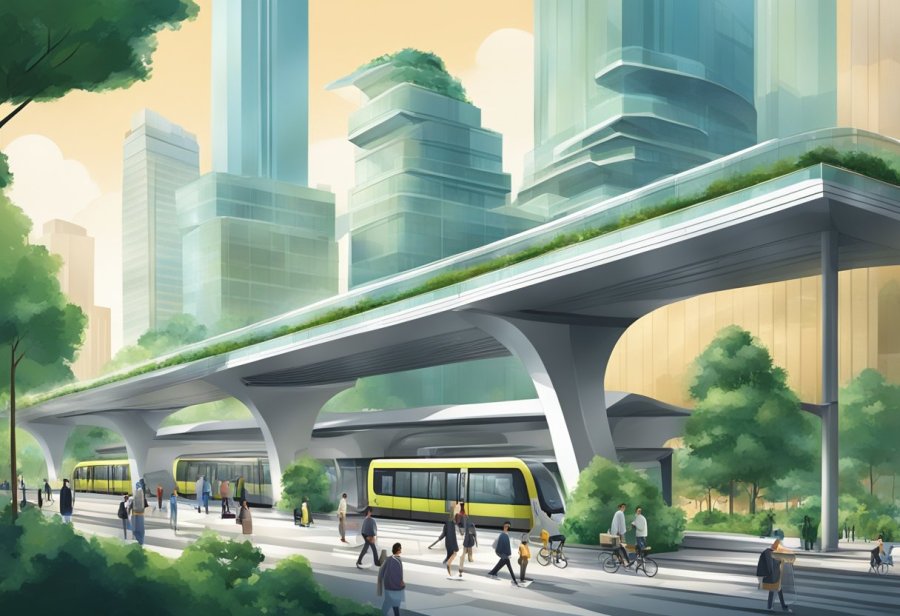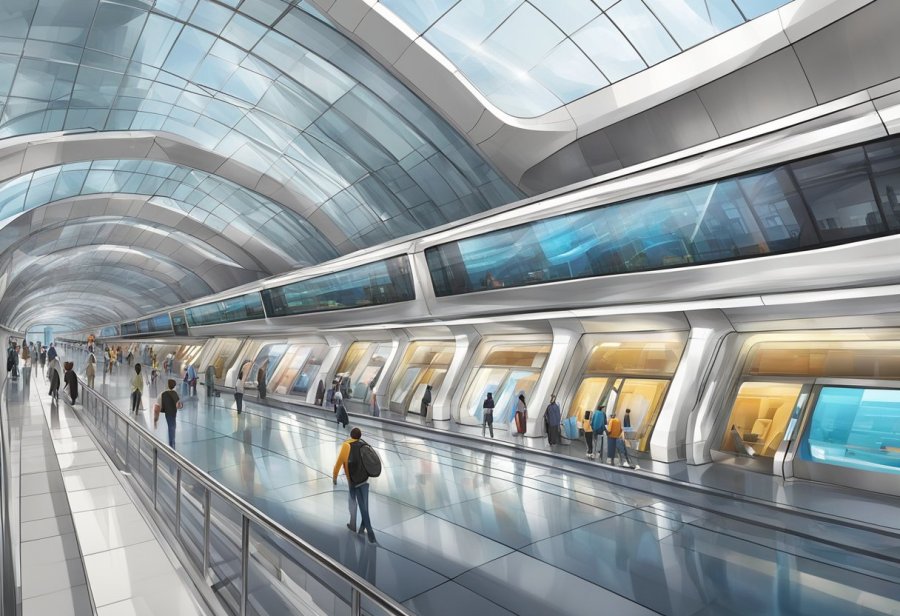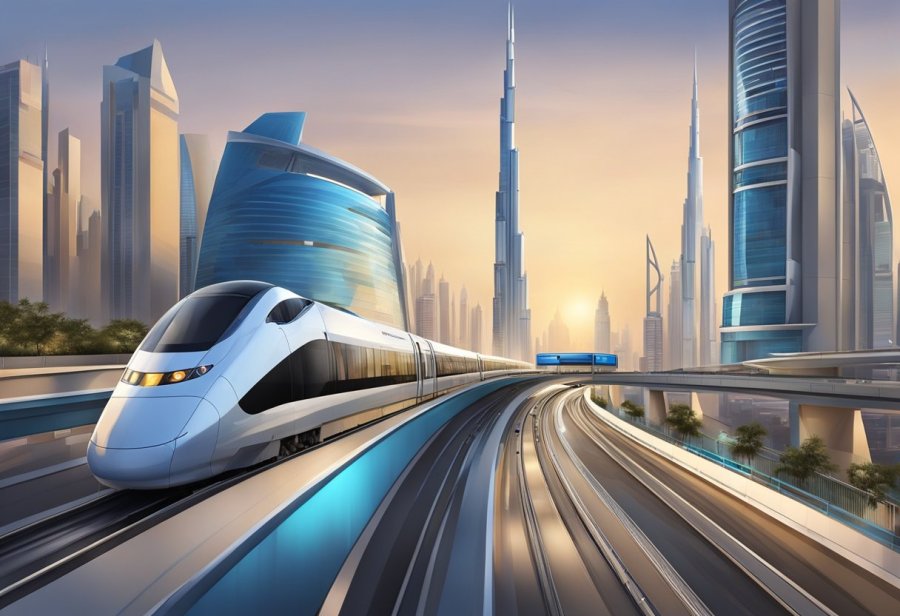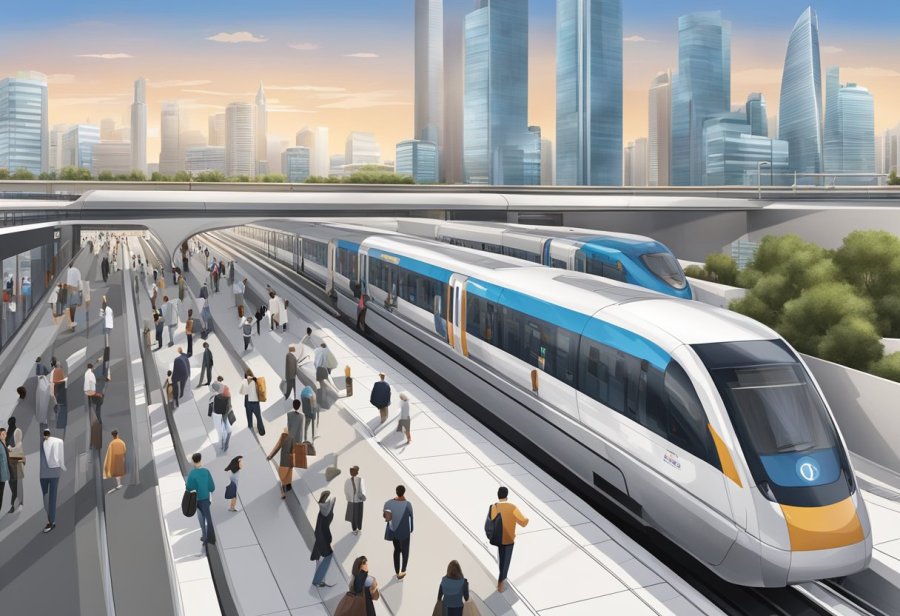Emirates Metro Station is a key location on the Red Line of the Dubai Metro. It’s situated at the strategic junction of Airport Road and Marrakech Street in the Garhoud area. This station stands out for its direct connection to the Emirates Group headquarters, providing convenient access for the employees and visitors of one of the world’s largest airline operators. Its proximity to Dubai International Airport makes it a vital hub for travellers looking to transition smoothly between the aerial and the rail network of Dubai.
- Emirates Metro Station Timings to Expo 2020 – First Train and Last Train Timings
- Emirates Metro Station Timings to Centrepoint – First Train and Last Train Timings
- History and Development
- Dubai Metro Network
- Emirates Metro Station Specifics
- Tickets and Fares
- Using the Dubai Metro
- Connectivity and Landmarks
- Public Transportation Integration
- Technical Aspects
- Economic and Environmental Impact
- Travel Tips and Recommendations
- Future of Transportation in Dubai
- Frequently Asked Questions
- Which line does the Emirates Metro Station serve?
- What are the operating hours for the Emirates Metro Station?
- What facilities are available at the Emirates Metro Station?
- How does one transfer between lines at the Emirates Metro Station?
- What is the distance from the Emirates Metro Station to the nearest shopping mall?
- Are there any landmarks or tourist attractions accessible from the Emirates Metro Station?

The Red Line, one of the lines of the Dubai Metro, boasts many stations, but the Emirates Metro Station has a unique significance due to its association with the Emirates Group. The station caters to a high number of passengers owing to its location in a busy commercial area that’s also near residential neighbourhoods. The efficiency of service and connectivity offered by the station encapsulates Dubai’s commitment to excellence in public transportation.
Designed to accommodate the fast-paced lifestyle of Dubai’s residents and visitors, the metro station provides features that ensure comfort and convenience. This includes retail outlets, eateries, and user-friendly navigation systems, which complement the city’s modern infrastructure. The design and operation of Emirates Metro Station reflect the innovative and forward-thinking spirit that Dubai is known for, making it more than just a stop on the map—it’s an integral part of the city’s transit ecosystem.
Emirates Metro Station Timings to Expo 2020 – First Train and Last Train Timings

Emirates Metro Station Timings to Centrepoint – First Train and Last Train Timings

History and Development

The history of Emirates Metro Station is integral to the story of Dubai’s rapid transportation evolution. It stands as a testament to the United Arab Emirates’ commitment to futuristic infrastructure and urban mobility solutions.
Initial Planning
The conception of Emirates Metro Station was part of a larger vision for Dubai’s development. This station was specifically designed to mesh seamlessly with the broader Dubai Metro network, enhancing connectivity across the sprawling urban landscape of Dubai. The initial design was focused on addressing the transport needs of the growing population, with a specific aim to facilitate easy access to the Emirates Group headquarters.
Construction Phases
Construction of the Dubai Metro Red Line began in 2005, and by September 2008, an impressive workforce comprising over 24,000 engineers, technicians, and labourers was mobilized to bring this ambitious project to life. The Emirates Metro Station, not being part of the initial stations of the Red Line, which opened on 9 September 2009, required additional time for its completion. It features a layout with two side platforms and two tracks, tailored to handle a significant daily throughput of passengers.
Inauguration and Expansions
The station officially opened on 30 April 2010, enhancing the connectivity of the city’s public transport system. Noteworthy is its role during events like Expo 2020, when the station, along with others on Route 2020, played a pivotal role in shuttling visitors to and from various Expo venues. The Route 2020 expansion was a particularly significant development, underlining Dubai’s capacity to host large-scale international events while providing sustainable urban transportation options.
Dubai Metro Network

The Dubai Metro Network, consisting of the Red Line and Green Line, serves as a comprehensive rapid transit system connecting various key locations across Dubai, with plans for further expansion.
Overview of Lines
The rail network includes two primary lines: the Red Line and the Green Line. The Red Line runs from Rashidiya to UAE Exchange, cutting through the heart of the city and reaching key destinations such as the Dubai International Airport. The Green Line spans from Etisalat Metro Station to Creek Station, traversing the densely populated areas of Deira and Bur Dubai.
Key Stations and Terminals
Among the 47 stations, certain nodes stand out due to their strategic locations and connectivity. Union Metro Station, for instance, is a pivotal interchange station where the two lines meet, facilitating efficient transitions for passengers. Other significant stations include DMCC Metro Station, catering to the Jumeirah Lakes Towers region, and Nakheel Harbour and Tower Metro Station, which is not only a station but also a major terminus for the Red Line.
Expansion and Future Plans
The Dubai Metro Network is set to expand its reach, enhancing connectivity within the Emirate. This is part of an overarching goal to extend the rail network, ensuring that it continues to serve as an effective mode of rapid transit in an ever-evolving Dubai. While specifics of the expansion are subject to change, the network’s growth reflects the city’s development trajectory.
Emirates Metro Station Specifics

Emirates Metro Station serves as a critical hub in Dubai’s extensive transportation network, offering efficient connectivity and vital services to commuters.
Location and Accessibility
Emirates Metro Station is situated at the intersection of Airport Road and Marrakech Street in the Garhoud area, adjacent to the Emirates Group Headquarters. It is notably close to Dubai International Airport, making it a strategic location for both local and international travellers. The station provides comprehensive accessibility options, including lifts for those with mobility needs.
Facilities and Services
The station boasts modern facilities to ensure a comfortable transit experience. Besides the essential ticketing services, the station offers retail and food outlets. For the visually impaired, there are tactile guide paths, and RTA Dubai ensures that the station is maintained to high cleanliness and operational standards.
Connecting Transit Options
Emirates Metro Station is a part of the Red Line of the Dubai Metro, seamlessly connecting passengers to key destinations like Emirates Towers and Al Qusais. A variety of bus and taxi services are available upon exiting the station, providing onward travel options throughout the United Arab Emirates.
Tickets and Fares

Emirates Metro Station facilitates passenger movement with uncomplicated ticketing options and pricing structures based on the zonal system. Commuters can purchase and utilize prepaid Nol Cards or obtain tickets from the station to journey across Zone 5 and beyond.
Nol Cards and Payment Methods
At Emirates Metro Station, passengers can procure different types of Nol Cards, which serve as a convenient cashless payment method for all public transport in Dubai. There are various types of Nol Cards such as Red, Silver, Gold, and Blue, each catering to different needs and offering varied benefits. Commuters can top-up these cards with credit at vending machines or ticket offices at the station.
- Payment Methods include:
- Cash
- Credit/Debit cards
- Nol Card top-up
Fare Zones and Pricing
Dubai’s public transport system is divided into seven fare zones. Emirates Metro Station falls within Zone 5, and fares for journeys to different zones are calculated based on the number of zones crossed. The cost for a single trip can range from a minimum fare for short trips within the same zone to a maximum fare for crossing multiple zones.
- Fare structure example:
- Within Zone 5: Lower fare
- Crossing into additional zones: Incremental increase
Ticket Office and Automated Services
Passengers have the option to buy tickets or top up their Nol Cards at the ticket office staffed with knowledgeable attendants, or through user-friendly automated services. Automated services include vending machines and smart kiosks, providing quick service for those who are on the go.
- Services Available:
- Staff-assisted ticket sales and Nol Card top-ups
- Self-service machines for ticket purchases and Nol Card top-ups
Using the Dubai Metro

Navigating Dubai is efficient with its well-organized metro system. The Dubai Metro gives residents and tourists alike a reliable mode of travel across the city, with precise timings and comprehensive network coverage. Ready access to information via the RTA app makes planning your journey straightforward.
Riding the Metro
Riders can access the metro at various stations, including prominent ones like Union and Danube. The metro generally operates from early morning to late at night, but timings can vary depending on the day and festivities. Platforms are designed for easy embarkment and disembarkment, supporting a smooth travel experience. Passengers are advised to check the latest schedule on the RTA app to plan their journeys efficiently.
Passenger Etiquette
Proper behaviour is expected on the metro to maintain a comfortable environment for all passengers. This includes refraining from eating and drinking while on board, giving up designated seats to those in need, such as the elderly or pregnant, and respecting quiet zones. Queuing in an orderly fashion before boarding and waiting for passengers to alight before entering is also part of the etiquette.
Safety and Regulations
Safety is a primary focus in the operation of the Dubai Metro. There are clear regulations in place to ensure the well-being of passengers. Regulations include prohibitions against smoking and vandalism to maintain clean and functional facilities. Emergency procedures are visibly displayed, and emergency contact points are accessible throughout the metro for immediate assistance if needed. Passengers are required to follow these guidelines to ensure the safety and efficiency of the metro service for everyone.
Connectivity and Landmarks

Emirates Metro Station serves as a hub that connects visitors and residents to a variety of destinations, including major shopping centres, iconic landmarks, luxurious hotels, and residential neighbourhoods.
Tourist Attractions
- Burj Khalifa: Easily accessible via the metro, this skyscraper is an emblematic structure of Dubai’s skyline.
- Dubai Mall: A short ride from the station, Dubai Mall offers an unparalleled shopping and entertainment experience.
Hotels and Accommodation
- Hotels: The Address Downtown is just one of the high-end hotels near the station, catering to both leisure and business travellers.
- Accommodation: There are quality accommodations for varying budgets, ensuring convenience and comfort.
Malls and Shopping Centers
- Mall of the Emirates: This shopping haven is just a metro trip away, boasting a diverse range of retailers and family-friendly attractions.
- Centrepoint and BurJuman: These centres provide a mix of shopping, dining, and entertainment options, and they are also situated on the metro line.
Residential Areas
- Sobha Realty: Sobha Realty’s residential developments are connected through the metro network, highlighting urban living.
- Residential Neighborhoods: The station is a gateway to several residential areas, offering easy daily commutes for inhabitants.
Public Transportation Integration

The Emirates Metro Station serves as a critical node in Dubai’s public transport network. It facilitates seamless connectivity for commuters through various modes of transit. It emphasizes efficient, time-saving travel by integrating metro services with bus and taxi services, as well as tram stations.
Bus Feeder Services
The Emirates Metro Station utilizes feeder bus services to extend the convenience of the metro to nearby areas. Specifically, Feeder Bus F08 operates as a key service, connecting the station with several prominent localities, including Al Nahda. This creates an accessible pathway for passengers to interchange between the metro and the extensive bus network, ensuring that areas further afield like Dubai Internet City and Dubai Festival City are well-connected.
Taxi Services
Adjacent to the Emirates Metro Station is a dedicated taxi rank, that provides immediate and efficient taxi services. Passengers often prefer taxis for direct, door-to-door transportation from the station, which is beneficial for reaching destinations not directly served by the metro or buses, such as Naif Park. Taxis complement public transport by increasing the catchment area of the metro.
Tram Stations and Services
Connectivity to tram stations offers another layer of integration with the Emirates Metro Station. Tram services help bridge the gap between the metro and waterside destinations, giving passengers a scenic and practical option for their commute. This link extends the public transport reach, encouraging more people to opt for these eco-friendly modes of transportation over personal vehicles.
Technical Aspects

The Emirates Metro Station embodies advanced technology in its rail systems. It uses top-of-the-line rolling stock, state-of-the-art signalling, and robust infrastructural support to ensure efficiency and safety within the Dubai Metro network.
Rolling Stock and Equipment
The Emirates station operates on the Red Line, with rolling stock provided by Kinki Sharyo, a renowned Japanese firm. The trains are designed for driverless operation, offering a high-tech travel experience. They run on standard gauge tracks, which is a widely adopted railway track gauge that facilitates maintenance and interoperability.
- Train Features:
- Driverless operation capabilities
- Manufactured by Kinki Sharyo
- Standard gauge railway system
Signalling and Automation
The station boasts an advanced signalling and automation system. This system is critical to the safe and efficient movement of trains through the network. The technology enables the trains to be remotely controlled and monitored by the Roads & Transport Authority (RTA), minimizing human error and optimizing traffic flow.
- Automation Levels:
- Fully automated train dispatch and control
- Real-time monitoring by RTA
Infrastructure and Maintenance
The Emirates Metro Station’s infrastructure is highlighted by its viaduct construction, which allows trains to pass above the city’s bustling roads. This design by the Roads & Transport Authority minimizes land use and integrates seamlessly with the existing urban environment. The maintenance of the station and its corresponding infrastructure is key to ensuring the longevity and reliability of the service.
- Design and Maintenance:
- Viaduct-style construction to minimize land use
- Strategically located near major roads for accessibility
- Regularly maintained by RTA to ensure service reliability
Economic and Environmental Impact

The Dubai Metro has had a significant influence on the local economy and urban development, while its sustainability initiatives underscore the environmental benefits it brings to the city. The impact is evident in property value increases and cost savings, as well as in the strategic link it provides between key areas such as Emirates Group HQ and Dubai International Airport.
On Local Economy
Properties within a 15-minute walk of a Dubai Red Line metro station, which includes the station at the Emirates Group Headquarters, have experienced an average price increase of 26.7%, surpassing Dubai’s average increase. The Dubai Metro Report 2023 by CBRE UAE provides specific data on this growth, indicating the substantial impact on local real estate. The cost-benefit effect of the Dubai Metro on the city’s economy is also substantial, with a ratio of 1.6 by the end of 2016, signaling financial benefits that outweigh the development and operational costs.
On Urban Development
The strategic placement of metro stations has fostered connectivity between various city zones, enhancing access to areas such as Ras Al Khor and facilitating streamlined travel alongside Airport Road. This has spurred urban development, as well-connected areas tend to attract more investment and development. The impact is particularly noticeable near transport hubs such as the station located at the Dubai International Airport, where an increase in commercial activities and real estate development can be attributed to the improved accessibility provided by the metro.
Sustainability Initiatives
Dubai Metro incorporates several sustainability initiatives, which have been effective in reducing the city’s carbon footprint and contributing to its environmental goals. The Environmental Report 2010-2011 published by Emirates indicates the eco-conscious infrastructure of the metro stations, including the one at the Emirates Group Headquarters. These measures include energy-efficient systems and practices that align with the ecology of the area, including Ras Al Khor’s protected wetlands.
Travel Tips and Recommendations
When planning a visit to the Emirates Metro Station, travellers should consider the best times to travel, how accessible the station is for tourists, and what kind of customer service and support to expecting.
Best Times to Travel
Weekdays: Monday to Thursday is often the optimal time to use the metro, especially outside of peak hours (8:00 am – 10:00 am and 4:30 pm – 7:00 pm), to avoid crowds.
Weekends: On Friday, the metro extends its service until 01:00 am, which is convenient for visitors heading to late-night events or the Dubai Festival City Mall.
Accessibility for Tourists
- Nol Card Purchase: Tourists can easily purchase a Nol card at any station to travel across different zones in Dubai. The Emirates Station is specifically connected to key locations, such as the airport and Dubai Festival City Mall, facilitating convenient access for tourists.
- Nearby Facilities: There are several restaurants and cafes within a short walking distance of the station, providing travellers with options for dining and refreshments.
Customer Service and Support
- Information Kiosks: These are available for travellers who need assistance or have inquiries about the metro system and the surrounding area.
- Security Personnel: They are stationed throughout the metro, ready to provide support or address safety concerns that passengers might have.
Future of Transportation in Dubai
As Dubai continues to grow, the city’s transportation infrastructure is rapidly evolving. The Roads and Transport Authority’s strategic vision ensures that mobility within the city becomes more efficient, accessible, and technologically advanced.
Strategic Planning
Strategic planning for transportation in Dubai involves meticulous design and forecasting to accommodate the future needs of residents and visitors. The central areas, including Business Bay and the Dubai Marina, are focal points for connectivity improvements, ensuring seamless transit between these bustling districts and pivotal hubs like Rashidiya and Jabal Ali.
Innovation in Mobility
The push for innovation is evident in the integration of state-of-the-art technologies and smart services. Autonomous vehicles and advanced traffic management systems are gradually setting the stage for a more futuristic approach to city transit. Places like Al Rigga and the GGICO stations look forward to enhancements in service efficiency and passenger experience.
Expansion of the Metro Network
The expansion of the metro network is a cornerstone for bolstering Dubai’s transport landscape. Recently, the Dubai Metro Blue Line has been a subject of interest, signifying the expansion of over 30 kilometres and the addition of new stations. This development is poised to better serve areas like the World Trade Center, ensuring that key points across the city are well-connected through public transit.
Frequently Asked Questions
This section addresses common inquiries regarding the Emirates Metro Station, offering essential information for travellers.
Which line does the Emirates Metro Station serve?
Emirates Metro Station operates on the Red Line of the Dubai Metro, providing access to key destinations across the city.
What are the operating hours for the Emirates Metro Station?
The station functions within the standard Dubai Metro operating hours, which vary on weekdays and weekends.
What facilities are available at the Emirates Metro Station?
It includes various amenities such as retail outlets, easy access for people with disabilities, and direct connectivity to the Emirates Group headquarters.
How does one transfer between lines at the Emirates Metro Station?
Emirates Metro Station does not facilitate line transfers directly. Passengers need to transfer at designated interchange stations along the Dubai Metro network.
What is the distance from the Emirates Metro Station to the nearest shopping mall?
The station is situated near several shopping malls, providing passengers with convenient shopping options.
Are there any landmarks or tourist attractions accessible from the Emirates Metro Station?
You can easily access several landmarks and tourist attractions from the station, making it a strategic starting point for tourists exploring Dubai.






